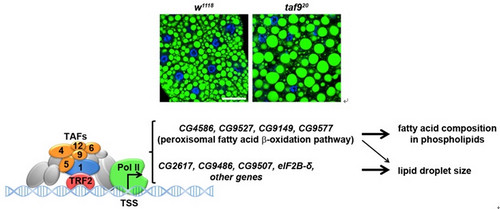Lipids are the major form of energy stored in organisms. Disorders of lipid storage and lipid metabolism lead to many severe human diseases, such as obesity, fatty liver and diabetes. Lipid droplets (LDs) are main lipid storage structures in most cells. The size of LDs is closely related to different cellular functions or metabolic status. Previous studies have identified numerous regulatory mechanisms of lipid storage and LD dynamics. However, our understanding of the lipid storage network and regulation of LD dynamics is far from clear.
The recent study in HUANG Xun’s lab from Institute of Genetics and Developmental Biology, Chinese Academy of Sciences, identified that general transcription factors, including TRF2 and TAF9, regulate LD size and phospholipid fatty acid composition in Drosophila larval fat body.
Inactivation of trf2 and taf9 results in large LDs and increased level of fatty acids with long chain lengths in phospholipids. We found that TRF2 and TAF9 affect these biological processes by modulating the transcription of a common set of genes, including peroxisomal fatty acid b-oxidation-related genes and other genes such as eIF2B-d. Overexpression of several target genes could partially rescue the LD phenotype of trf2 mutants.
Their findings therefore reveal that general transcription factors, which were previously thought to be involved in the transcription of all genes, can play a specific role in lipid homeostasis.
This work was supported by grants from the Strategic Priority Research Program of the Chinese Academy of Sciences, the National Basic Research Program of China and the National Natural Science Foundation of China.
 |
|
Figure. TRF2 affects LD size by directing transcription of several target genes. (Image by IGDB) |
Contact:
Dr. HUANG Xun
 Figure. TRF2 affects LD size by directing transcription of several target genes. (Image by IGDB)Contact:Dr. HUANG XunEmail: xhuang@genetics.ac.cn
Figure. TRF2 affects LD size by directing transcription of several target genes. (Image by IGDB)Contact:Dr. HUANG XunEmail: xhuang@genetics.ac.cn CAS
CAS
 中文
中文




.png)
